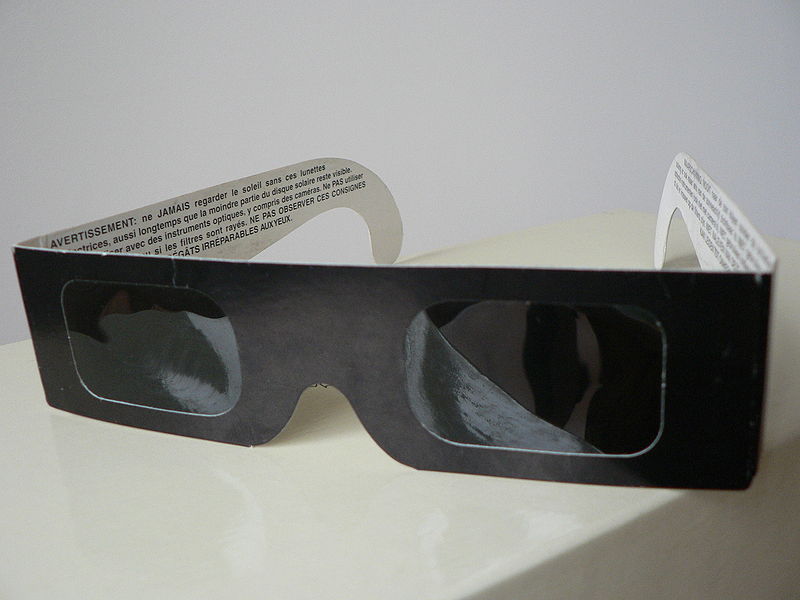Astronomical Info / 天文資訊 > Special Astronomical Events / 特別天文事件 > Solar Eclipse Basic Knowledge 日食基礎知識 [Refresh 更新]
[Back to the previous page 返回上頁]
This page describes the mechanism of solar eclipses and how to observe it safely. 本頁簡單介紹日食的成因和怎樣能夠安全地觀賞日食。
 Solar eclipse basic knowledge 日食基礎知識 Solar eclipse basic knowledge 日食基礎知識 |
The following information is quoted from Wikipedia. 以下資料摘自維基百科。
A solar eclipse occurs when the Moon passes between the Sun and the Earth so that the Sun is wholly or partially obscured. This can only happen during a new moon, when the Sun and Moon are in conjunction as seen from the Earth. At least two and up to five solar eclipses occur each year on Earth, with between zero and two of them being total eclipses. Total solar eclipses are nevertheless rare at any location because during each eclipse totality exists only along a narrow corridor in the relatively tiny area of the Moon's umbra.
日食,又作日蝕,是一種天文現象,只在月球運行至太陽與地球之間時發生。這時,對地球上的部分地區來說,月球位於太陽前方,因此來自太陽的部分或全部光線被擋住,因此看起來好像是太陽的一部分或全部消失了。日食是相當罕見的現象,在四種日食中較罕見的是日全食,因為唯有在月球的本影投影在地球表面時,在該區域的人才能夠觀測到全食。日食一定發生在朔,即農曆初一當日。此時月球位於地球和太陽之間時,但因太陽軌道(黃道)與月球軌道(白道)成5°9′交角,故並非每次朔日皆有日食發生,而日食發生時,日月兩者皆一定在「黃白交點」(升交點或降交點)附近發生。

There are four types of solar eclipses:
- A total eclipse occurs when the Sun is completely obscured by the Moon. The intensely bright disk of the Sun is replaced by the dark silhouette of the Moon, and the much fainter corona is visible. During any one eclipse, totality is visible only from at most a narrow track on the surface of the Earth.
- An annular eclipse occurs when the Sun and Moon are exactly in line, but the apparent size of the Moon is smaller than that of the Sun. Hence the Sun appears as a very bright ring, or annulus, surrounding the outline of the Moon.
- A hybrid eclipse is intermediate between a total and annular eclipse. At some points on the surface of the Earth it is visible as a total eclipse, whereas at others it is annular. Hybrid eclipses are rather rare.
- A partial eclipse occurs when the Sun and Moon are not exactly in line, and the Moon only partially obscures the Sun. This phenomenon can usually be seen from a large part of the Earth outside of the track of an annular or total eclipse. However, some eclipses can only be seen as a partial eclipse, because the umbra never intersects the Earth's surface.
日食可以分為四類:
- 日全食:太陽光球完全被月亮遮住,原本明亮的太陽圓盤被黑色的月球陰影遮蓋。然而,也只有在日全食發生時才可能用肉眼觀測到模糊的日冕。日全食只在月球位於近地點時發生,此時月球的本影 (Umbra) 錐長度較月地之間距離長,本影錐才能掃到地球表面。由於太陽的實際體積比月球大很多,所以日全食通常只能在地球上一塊非常小的區域見到,因為月亮的本影對太陽來說只是一個小點。(在全食區之外,所見的食相是偏食)
- 日偏食:造成日偏食的原因是因為觀測者落在月球的半影區 (Penumbra) 中,觀測者會看見一部分的太陽被月球的陰影遮蓋,但另一部分仍繼續發光。太陽和月球只有部分重合,依據兩者中心的視距離遠近(太陽被月球遮蓋的最大直徑)來衡量食的大小。通常日偏食是伴隨著其他食相發生,如日全食。但某些日食只可能是日偏食(不伴隨其他食相),因為月球與地球的距離太遠,只有半影碰到地球表面。
- 日環食:當月球處於遠地點時,月球的本影錐不能到達地球;到達地球的是由本影錐延長出的偽本影錐 (Antumbra)。此時月球的視直徑略小於太陽。因此,這時太陽邊綠的光球仍可見,形成一環繞在月球陰影周圍的亮環。(在環食區之外,所見的食相是偏食)
- 全環食:全環食只發生在地球表面與月球本影尖端非常接近,或月球與地球表面的距離和月本影的長度很接近的情形下。由於地球為球體之關係,而本影影錐接觸地球時為日全食(常為在食帶中間),在食帶兩端由於影錐未能接觸地球,致只能有偽本影到達地球之下,所看到的是日環食。所以,當全環食發生時,隨著地月之間的相對運動,會先後出現環食→全食→環食。全環食發生機率甚少,最近的一次在2005年4月8日。
 |
|
English version: for the geometry involved and activities during solar eclipse, please read the Wikipedia article.
 Observing solar eclipses safely 如何安全觀看日食 Observing solar eclipses safely 如何安全觀看日食 |
The following information is quoted from Wikipedia. 以下資料 (除最後一段) 摘自維基百科。
Looking directly at the photosphere of the Sun (the bright disk of the Sun itself), even for just a few seconds, can cause permanent damage to the retina of the eye, because of the intense visible and invisible radiation that the photosphere emits. This damage can result in permanent impairment of vision, up to and including blindness. The retina has no sensitivity to pain, and the effects of retinal damage may not appear for hours, so there is no warning that injury is occurring. Sunglasses are not safe, since they do not block the harmful and invisible infrared radiation which causes retinal damage. Only properly designed and certified solar filters should ever be used for direct viewing of the Sun's disk.
The safest way to view the Sun's disk is by indirect projection. This can be done by projecting an image of the disk onto a white piece of paper or card using a pair of binoculars (with one of the lenses covered), a telescope, or another piece of cardboard with a small hole in it (about 1 mm diameter), often called a pinhole camera. The projected image of the Sun can then be safely viewed; this technique can be used to observe sunspots, as well as eclipses. However, care must be taken to ensure that no one looks through the projector (telescope, pinhole, etc.) directly.
Eclipse glasses 觀看日食專用眼鏡
It is safe to observe the total phase of a solar eclipse directly with the unaided eye, binoculars or a telescope, when the Sun's photosphere is completely covered by the Moon; indeed, this is a very spectacular and beautiful sight, and it is too dim to be seen through filters. The Sun's faint corona will be visible, and even the chromosphere, solar prominences, and possibly even a solar flare may be seen. However, it is important to stop directly viewing the Sun promptly at the end of totality. The exact time and duration of totality for the location from which the eclipse is being observed should be determined from a reliable source.
請注意:千萬不要直接目視太陽,即使是在黃昏或日環食時。因刺眼的太陽光(光球)引起視網膜破壞而影響視力。需使用保護措施直視(如專用於目視太陽觀測的濾光片、焊接用14號或以上的護目眼鏡),最好以投影法觀看(如簡單的針孔照相機在紙上成像,或利用望遠鏡把太陽影像投影於白紙上)。以墨水倒影,隔著煙薰黑的玻璃、已曝光的底片、光碟片、太陽眼鏡因為不能過濾紫外線,令減光效果不良,皆不安全。
可是,當整個太陽被月球幅蓋時,是可以不用輔助器材而觀看全食過程的;利用專門設計的器材反而會因全食時光度不足而無法清楚觀看。然而當全食結束,太陽的邊緣重新出來時,必須立即停止以肉眼直接觀看。應預先由可信的來源獲取確實的全食時間。
More info 更多資料:
- English:
- NASA's eclipse web site: http://eclipse.gsfc.nasa.gov/SEhelp/safety.html
- MrEclipse.com: http://www.mreclipse.com/Totality2/TotalityCh11.html
- 中文:
- 日食的觀測 --- 七. 觀測日食的安全方法 http://www.hkastroforum.net/viewtopic.php?t=1142
Last Accessed 最近訪問日期: Tue Apr 30 2024 02:36:20 HKT
Last Modified 最近修訂日期: Mon Jul 24 2023

